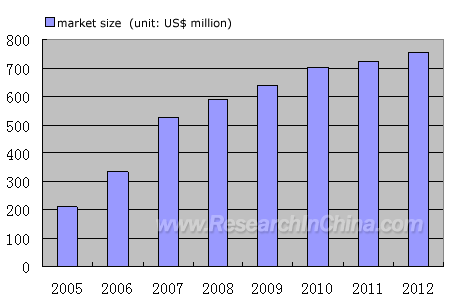|
Nowadays, some portable electronics, some home audio/video devices and more and more car audio system are changing to the application of class-D audio amplifier. The market of Class-D audio amplifier is growing at a rate of above 50 percent. In 2008, its market size is expected to reach nearly US$600 million.
Statistics and Forecast of Global Class-D Audio Amplifier Market Size 2005-2012

Source: ResearchInChina
Class-D audio amplifier applied in handsets accounts for more than 50% of the market share, and it mainly has the following types, TPA2010D1, TPA2012D2, TPA2005D1, YDA144, YDA1454, TPA4411, TPA6310A2, and SAPA1D2. New mobile phones, especially Nokia's new handsets, apply a large amount of Class-D audio amplifiers, and use a pair of amplifiers, one is headphone driver and the other is loudspeaker driver.
Regarding the television market, utilization ratio of Class-D audio amplifier in flat panel television with screen sizes of above 40 inches is about 50%. Class-D audio amplifiers IC commonly applied in televisions are NeoFidelity's NTP3000 and TI's TPA3002, 3004 and 3008. Around 15% multimedia sound boxes apply Class-D audio amplifier. Small home theater equipment also uses Class-D audio amplifier, but the market is relatively small.
After-market audio with high power mostly adopts Class-D audio amplifier, as the working conditions of auto acoustics are harsh, requiring high temperature resistance and minimum reduction of heat. Besides, auto acoustics require small size, due to limited space in a car. Most of Japanese producers prefer Class-D. For instance, all of Alpine's acoustics power amplifiers use Class-D, while Kenwood's KAC-9104 and KAC8104 and Pioneer's PRS-D2000SPL, PRS-D1200SPL, PRS-D1200M, PRS-D4200F and PRS-D2200F also use Class-D. American manufacturers are relatively conservative, and producers like JBL and Rockford Fosgate still persist in using Class-AB amplifier. The output power of these auto acoustics are all above 50 watts and can be as high as nearly 10,000 watts. Yet, the sound quality of big power Class-D is inferior to that of Class-AB. The power amplifiers developed by Clarion can be converted between Class-AB and Class-D, which are, however, all limited to auto aftermarket that is less than 1% of auto before-market.
Regarding Class-D audio amplifier IC applied in mobile phone, TI possesses the absolutely dominant position in the market. In terms of its application in the television field, the market is carved up by several competitors.
Samsung supports NeoFidelity, which maintains a good relationship with Samsung. TI's key clients include Changhong and TCL, TV producers in Mainland China, while Panasonic, Sharp and Sony favor products of NXP and ST. The old brand National Semiconductor is declining, maybe because its Class-AB products are too successful.
|



